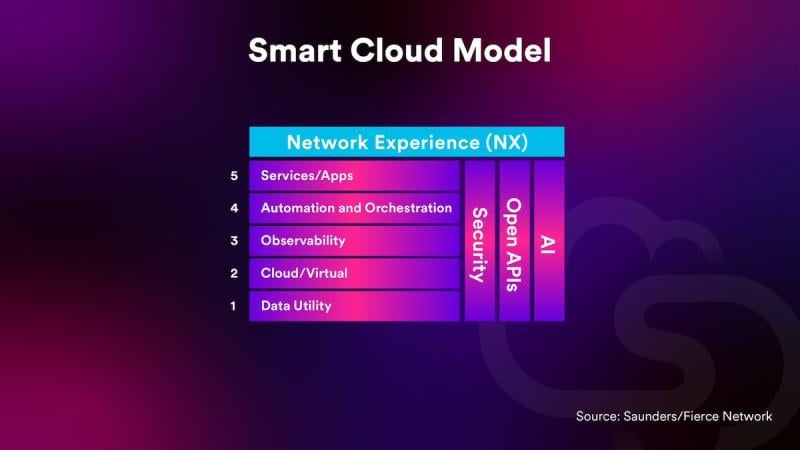-
‘Network Experience’ is the defining principle of Cisco’s visionary plan
-
Strategy is breathtaking in scope, complexity, and ambition
-
The comms industry is at the start of its greatest transition yet, says Cisco GM Davidson.
Cisco Systems has been something of an enigma recently, continuing its M&A drive, but keeping the over-arching strategy behind those purchases tantalizingly out of sight.
No longer.
Over the course of four hours at its San Jose, Calif., campus last week, fueled by cookies (mmm, cookies) and coffee, a succession of Cisco’s senior executives gave Fierce an exclusive in-depth tour of Cisco’s Cisco Networking Cloud strategy.
And what a blistering strategy it is.
Cisco Networking Cloud is part of the industry mega-trend amongst incumbent vendors to develop smart cloud portfolios that integrate observability, automation, AI, security and other critical functions over cloud infrastructure to create an environment where users can efficiently build and run new services and applications.
But Cisco Networking Cloud goes further than just providing the tools to perform this transition to infer a fundamental change to the role of comms infrastructure itself.
For me, the key tenet of Cisco Networking Cloud is a concept the company calls "Network Experience" (NX). In just the same way that user experience (UX) and customer experience (CX) look to define best practices for creating the ideal experience for users when interacting with digital devices and media, NX does the same thing for the end users and operators of communications networks.
I’ve updated Fierce Network’s smart cloud taxonomy to reflect this game-changing development (see image below).

A new look
What sort of experience does Cisco want network users to have?

The mega-vendor's goal is to make the network a given. Cisco envisions the network as an ultra-reliable, ultra-intelligent utility, concealing its innate complexity not only from the end users, but also the enterprises, service providers or vertical industries that operate the network.
“I first started thinking about this three or four years ago,” said Jonathan Davidson, EVP and General Manager of Cisco Networking, and the architect of Cisco Cloud Networking.
“It’s a deeply iterative process and success comes from deeply, intimately understanding our customers needs. We’ve taken a methodical approach to that, developing [the concept] with 100 customers," he said.
Cisco has also been on an M&A tear, buying a laundry list of companies with the capabilities it needs to deliver Cisco Networking Cloud. (IBM has done the same thing to build its Smart Cloud portfolio, which it calls Hybrid Cloud Mesh).
Two of Cisco’s most significant purchases are Thousand Eyes, and Splunk, which alone cost $28 billion. “We bought [Splunk] for the data…. Data is the new gold,” commented Davidson.
Integrating all of the new pieces of its new portfolio is a huge task, and a work in progress. “The key is how you simplify all of that,” Davidson said.
The 'start of the journey'
Cisco’s executives were uniformly pragmatic about the challenges ahead, and how long it will take to make its NX vision a reality. During my briefings, they variously described the current state of play as “the start of the journey,” “just getting started,” and “early days.”
This is laudable, especially in the wake of this year’s Mobile World Congress in Barcelona, which was significantly diminished by the volume of AI-washing, with some exhibitors simply reprinting signage to reference AI weeks prior to the event.
To implement Network Experience successfully, enterprises and carriers must do more than just buy Cisco Networking Cloud, they will need to buy into a cultural shift as well. (Clearly, Cisco has gone through the metamorphosis already). The payoff for doing so will be immense.
Cisco uses an internal metric to score its customers’ networks from 1 to 4 based on their current capabilities (see the chart below, shared exclusively with Fierce Network).
“Most of our [Cisco Observability Platform] customers are at about 1.2 – 1.5; a few are edging into 3; no one is at 4 yet,” said Joe Byrne, CTO advisor, Cisco Observability, whose job includes acting as an ombudsman for Cisco’s enterprise customers, ensuring that their voice — and their needs — are represented in the Cisco Observability Platform development.
Level 4 networks will support a slate of features that will make today’s networks seem antediluvian in comparison, including the ability to predict outages and take the necessary actions to head them off, automagically, without any human oversight.

Cisco Networking Cloud has direct competition from half a dozen companies, including Ciena's Blue Planet, Ericsson, IBM and Microsoft, which also have developed smart cloud portfolios. Despite the stiff competition, Cisco has some advantages in the fight, including its enterprise sales channel, which is considered an exemplar in the industry — Cisco has 20,000 full time sales professionals, supported by an even larger partner network.
Trust is equally important. Cisco has developed a reputation over three decades for helping both enterprise and service provider customers successfully undertake technology transitions at scale. It’s track record will be invaluable in encouraging its customers to undertake their biggest reinvention yet.
The big picture
Why is what Cisco is doing so significant? Because communications technology isn’t really about “communications” anymore and hasn’t been for a while. What started as a way for two people to talk remotely without shouting metamorphosed into a way to connect expensive office equipment before — wham! — shape-shifting into the internet and then — bam! — cloud.
But I’ve seen our artificially-intelligent-robot-future, and I know what’s coming, and it’s going to make everything that has happened in the communications industry until now seem quaint.
I’ve only met half a dozen people who truly understand the impact that this will have. Åsa Tamsons at Ericsson is one. Cisco’s Davidson is another. The rest work in Shenzhen.
So, the mission just changed, from building communications infrastructure, to building world-changing infrastructure. The small handful of companies who can deliver a way to do that most efficiently and securely will dominate for decades to come.
Victory will require revolutionary new ways of thinking, as well as radical new technology, like AI. That’s exactly what Cisco is doing with the concept of NX and, combined with its Cisco Networking Cloud portfolio and sales channel, it has the potential to catapult it back into a level of dominance it hasn’t enjoyed since the start of the century.
Cisco has so far only used the ‘Network Experience’ language internally. But I’m using it publicly, on the same day that we are launching the new Fierce Network, to place it on record as an essential new communications concept.
“Are you experienced?” sang Jimi Hendrix in 1967. Expect the communications industry and its customers to loudly join in with that refrain over the next 10 years.
Be sure to sign up for all of our newsletters here.